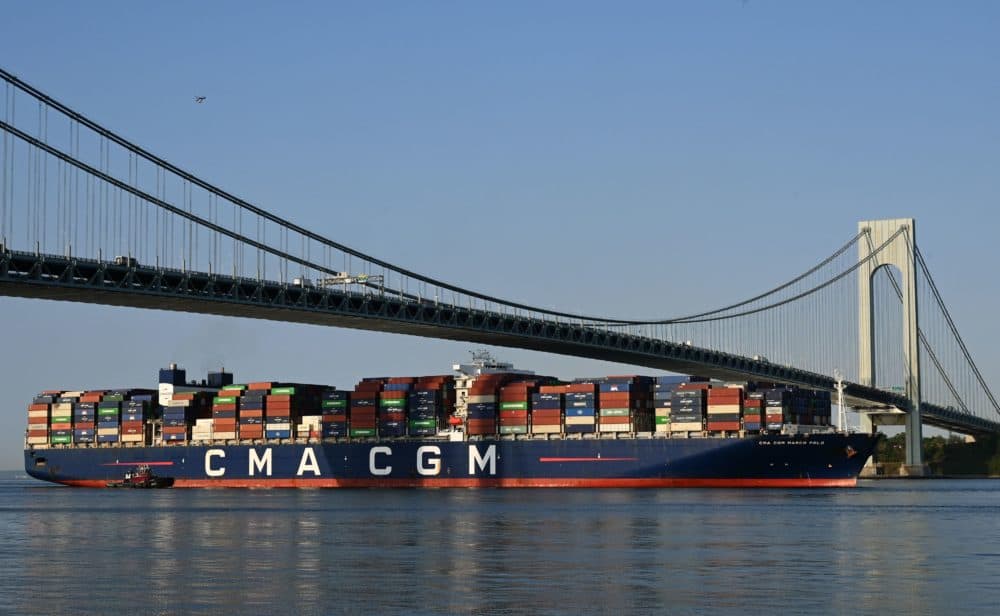Advertisement
What America's supply chain shortages mean for your buying, from phones to cars
Resume
Cars. Smartphones. Appliances.
An international chip shortage is squeezing supply chains and inventory.
How did this happen? And when will it end?
“There’s something just disconcerting about something suddenly not being available," Amy Davidson Sorkin says. "And when suddenly things are not getting to willing buyers from willing sellers, something seems off. You wonder where else the vulnerabilities are.”
Today, On Point: What America's supply chain shortages means for your buying.
Guests
Dr. Willy Shih, professor of management practice in business administration at Harvard Business School. (@WillyShih_atHBS)
Also Featured
Will Douglas Heaven, senior editor at MIT Technology Review.
Wyatt Olsen, CEO of Ultraviolet Audio Video in Santa Barbara, California.
Transcript: 'The story of a computer chip'
MEGHNA CHAKRABARTI: The semi-conductor chip. It's in your new phone, car, game console, kitchen appliances … or at least would be, if there weren’t a global shortage of these tiny tech wonders.
CHAKRABARTI: To better understand why you can’t buy that new car or phone right now, it’s worth understanding how the chip comes into being in the first place, under the best of circumstances.
CHAKRABARTI: And that story begins in the ground. With quartz, a mineral composed of silicon dioxide.
WILL DOUGLAS HEAVEN: The silicon that comes out of the ground probably crisscrosses the world two or three times before it ends up in your phone.
CHAKRABARTI: That’s Will Douglas Heaven. He’s a senior editor at MIT Technology Review.
HEAVEN: So the cool thing that I think a lot of people don't know ... is that although computer chips are everywhere, I mean, there are few places in the world that you'll be far from a computer chip. But every single one of those chips is made from this material silicon. And there aren't actually that many places in the world where silicon is found in the ground pure enough to use to make computer chips.
DOUGLAS HEAVEN: And there's one place in particular called Spruce Pine, that's a town in North Carolina. And there's a mine there where silica is found in sort of particularly pure quantities. That had been chopped away for ages, because what people were actually after for centuries was gemstones and this stuff called mica, which is used in paint. And it was only when the semiconductor industry took off in the 1980s that suddenly this quartz had new value and incredible value.
CHAKRABARTI: Spruce Pine, North Carolina. Population, about 2,200. Humans have been mining here for more than 2,000 years, as evidenced by Native tribes who dug down 100 feet to pull mica from the ground millennia ago. The mica was later used in several of Thomas Edison’s inventions, also in paint, as you heard. And the quartz extracted from the mines now is the purest in the world. So as Robin Townsend of the local chamber of commerce says, “If you have a computer, you have a little slice of Spruce Pine.” Will Douglas Heaven describes how they get the quartz out of the ground.
HEAVEN: And then these quartz rocks are dug up with machines and explosives, and then they're put into a crusher which crunches these rocks up into gravel. That gravel then goes to a processing plant where the quartz gravel is ground down further into a fine sand.
CHAKRABARTI: The sand is processed to separate out and refine the silicon.
HEAVEN: And it's been bagged up and and sent off to the next stage.
CHAKRABARTI: That next stage is where the pure elemental silicon starts looking like something more familiar. And there are only a few facilities around the world where this happens – such as SUMCO in Japan. Or Siltronic AG in Germany.
HEAVEN: The powder is melted down into cylinders. So you imagine a sort of a salami. And then we're getting close to what people would recognize as chips. This sort of ... cylinder is then finally sliced into wafers like you're chopping a cucumber or a salami. So you end up with these round thin disks.
CHAKRABARTI: And then, they’re shipped off again, to a factory that makes the actual chips. This could be in Austin, Texas. Incheon, South Korea. Hsinchu, Taiwan. Or even Hillsboro, Oregon.
HEAVEN: Once you get up to making chips themselves, which get printed onto this thin disk. This is extremely delicate, the conditions need to be sort of like lab conditions. You see pictures of workers in these chip factories wearing what looked like hazmat suits. You just can't have any kind of contamination. No dust, anything like that, because that will completely wreck the the mine circuitry on the chips that you’re trying to print on. And so any kind of little bit of dust that got into that would completely ruin it. Which is kind of cool. We've gone from the messy quarry with the dust and explosions, all the way now to sort of super, super clean labs, which is where the chips get made.
CHAKRABARTI: And as the chips get made, new materials are printed onto the wafers. These materials have their own complex supply chains as well. Things like copper, which might come from Chile. Or aluminum, which might come from China. Or boron, which might come from Turkey.
CHAKRABARTI: Then, the wafer is sent to yet another factory for testing, where microscopic probes assess whether the chip is working as required. They’re cut apart and put into packages — adding even more materials to the process.
CHAKRABARTI: And then they’re shipped off again ... to other factories where they are finally put them on circuit boards. And those factories are usually not in the same places as where the chip makes its final stop: assembly into cars, computers, phones and appliances.
From The Reading List
Forbes: "About That White House Meeting To Discuss The Semiconductor Supply Chain" — "The White House is hosting a virtual summit today to discuss the semiconductor supply chain."
The New Yorker: "The Supply Chain Mystery" — "A good way to get people talking, in this lingering pandemic era, is to ask whether they have tried to rent a car lately."
This program aired on October 4, 2021.

